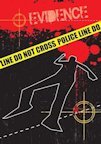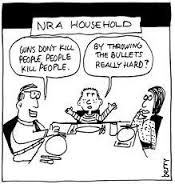Everyone on both sides of the gun debate knows John Lott. He’s been a leading promoter of the armed citizen nonsense since he published a book which claimed to find a connection between an increase in CCW and a decrease in crime. The fact that a review committee of the National Academy of Sciences was unable to replicate his findings using his own data was a minor stumble in what has become a full-blown career promoting the idea that carrying guns around protects us all from crime.
In 1997 Lott appeared before a committee of the Nebraska legislature and stated that he had conducted a national survey which showed that nearly all DGUs (defensive gun uses) involved brandishing but not actually firing a gun. When his survey results were challenged, Lott was unable to produce any data, claiming that it was lost when his hard drive crashed.
I’m not all that upset about the degree to which Lott has or hasn’t faked information about CCW, DGUs or anything else. The truth is that once the gun nuts found a willing sycophant who would cloak his pro-gun advocacy in some kind of ‘scientific’ or ‘academic’ approach, it didn’t really matter whether scholars on the other side of the debate agreed with him or not. In fact, the more that scholars like Harvard’s David Hemenway and Stanford’s John Donohue call Lott to account, the more the red-meat noise machine comes to his defense. And what the hell, a guy has to earn a living, doesn’t he?
But I’m beginning to think that Lott may have now gotten involved in a situation that even his most ardent friends and supporters may find it difficult to come to his defense. I’m referring to a story that appeared in Media Matters, regarding what appears to have been an effort by Lott to publish an article supporting guns on campus that was actually written not by him but by a Brown University student named Taylor Woolrich. In what can only be described as an act of journalistic identity theft, Lott got this op-ed piece published on Fox News.com, complete with a headline that read: “Dear Dartmouth, I am one of your students, I am being stalked, please let me carry a gun.” The piece was originally sent to Fox under both their names but was rejected, then Fox changed its mind and was willing to run the op-ed under Taylor’s name but she declined but gave Lott permission to send in the piece using her name. Except she didn’t give him permission to rewrite the entire piece, in particular the conclusion that starts with the following sentence: “Having a gun is by far the most effective way for victims to stop crime.” What Woolrich thought was going to be a story about the trauma of stalking turned into a Lott-inspired paean to the value of citizens carrying concealed guns.
This episode wouldn’t be so interesting were it not for the fact that John Lott seems to have an interesting history when it comes to using or inventing female identities to advance and defend his own career. In various web postings, particularly websites that were critical of Lott’s work, a former PhD candidate at Wharton named Mary Rosh defended Lott, calling him the “best professor I ever had.” There was only one little problem – Mary Rosh was actually John Lott and he has never adequately explained how or why this case of false identity came about.
There’s been a lot of chatter over the years, much of it harmless or aimless, about the alleged link between sexual inadequacy and gun ownership, the idea being that guys who feel impotent in the bedroom can compensate to their heart’s content when they pull out their AR and head to the range. In the case of John Lott, we have a major pro-gun personality who keeps using women, real or imagined, in ways that must leave him feeling embarrassed if not ashamed. And the saddest thing about it is that he always seems to get caught.




Recent Comments